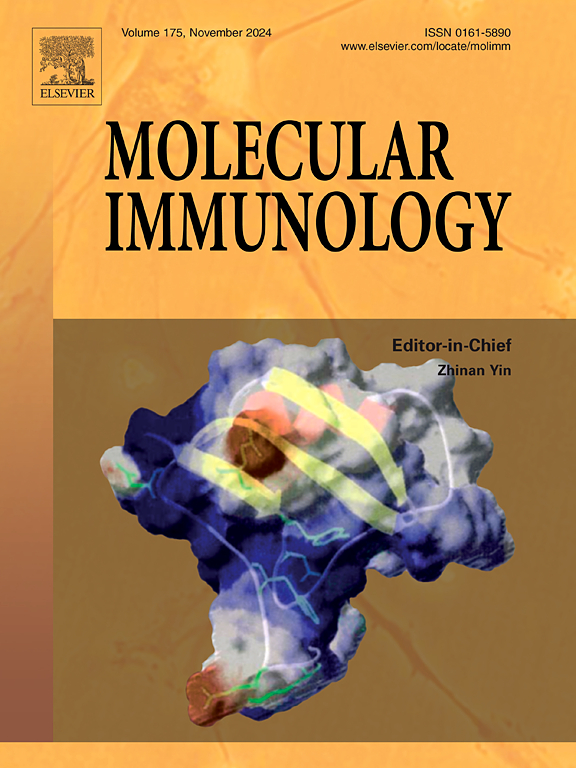木犀草素通过调节IL-33/ST2- GSK3β-M2巨噬细胞极化,减轻OVA引起的哮喘小鼠2型炎症
IF 3
3区 医学
Q2 BIOCHEMISTRY & MOLECULAR BIOLOGY
引用次数: 0
摘要
过敏性哮喘是一种常见的非感染性炎症性疾病,以2型炎症为特征。虽然有多种治疗选择,但由于哮喘的异质性,其疗效往往有限。木犀草素(LUT)是一种天然存在的类黄酮,已被证明在各种炎症条件下具有治疗潜力。本研究旨在探讨变应性哮喘的潜在发病机制,并通过IL-33/ST2信号通路评价LUT对变应性哮喘的治疗作用。我们用卵清蛋白(OVA)致敏和激发BALB/c小鼠,然后用LUT治疗,建立了小鼠变应性哮喘模型。采用病理染色、免疫组化染色(IHC)、酶联免疫吸附法(ELISA)、实时定量聚合酶链反应(RT-qPCR)、Western blot (WB)等方法评价LUT对过敏性哮喘小鼠的作用。此外,我们还使用IL-33刺激RAW264.7细胞。通过细胞计数Kit-8 (CCK-8)、RT-qPCR和WB等体外实验,探讨LUT对IL-33/ST2通路激活和M2巨噬细胞极化的可能机制。经证实,LUT对改善哮喘小鼠肺功能具有重要作用,其气道阻力降低23% %和48% % (p <; 0.05,与OVA/生理盐水组相比);通过降低2型炎症因子(IL-4、IL-5和IL-13)含量17 %-78 % (**p <; 0.01;***p <; 0.001 vs. OVA/生理盐水组);降低气道炎性细胞浸润54 %和65 % (***p <; 0.001与OVA/生理盐水组比较);抑制黏液分泌75 %和89 % (***p <; 0.001 vs OVA/生理盐水组)。机制研究表明,LUT可通过IL-33/ST2-GSK3β-M2巨噬细胞极化通路治疗哮喘,从而调节过敏性哮喘气道炎症、重塑和免疫反应。总之,这些发现支持LUT通过靶向调节IL-33/ ST2-GSK3β-M2巨噬细胞极化轴作为变应性哮喘的有前景的治疗剂。本文章由计算机程序翻译,如有差异,请以英文原文为准。
Luteolin attenuates type 2 inflammation in asthmatic mice induced by OVA by regulating IL-33/ST2- GSK3β-M2 macrophage polarization
Allergic asthma is a prevalent non-infectious inflammatory disease characterized by type 2 inflammation. Although multiple treatment options are available, their efficacy is often limited due to the heterogeneous nature of asthma. Luteolin (LUT), a naturally occurring flavonoid, has demonstrated therapeutic potential in various inflammatory conditions. The aim of this research is to investigate the underlying pathogenesis mechanisms of allergic asthma and to evaluate the therapeutic effects of LUT on allergic asthma via IL-33/ST2 signaling pathway. We established a murine model of allergic asthma by sensitizing and challenging BALB/c mice with ovalbumin (OVA), followed by treatment with LUT. The effects of LUT in allergic asthma mice were evaluated via the following techniques: pathological staining, Immunohistochemical staining (IHC), enzyme-linked immunosorbent assay (ELISA), real-time quantitative polymerase chain reaction (RT-qPCR) and Western blot (WB). Additionally, we also used IL-33 to stimulate RAW264.7 cells. Assays in vitro including cell counting Kit-8 (CCK-8), RT-qPCR and WB were performed to investigate potential mechanisms of LUT on IL-33/ST2 pathway activation and M2 macrophages polarization. LUT was verified to have crucial effects on ameliorating asthmatic mice lung function as evidenced by down-regulated airway resistance by 23 % and 48 % (p < 0.05 vs. OVA/saline group); regulating airway type 2 inflammation via decrease the content of type 2 inflammatory cytokines (IL-4, IL-5, and IL-13) by 17 %-78 % (**p < 0.01; ***p < 0.001 vs. OVA/saline group); decreasing airway inflammatory cells infiltration by 54 % and 65 % (***p < 0.001 vs. OVA/saline group); inhibiting mucus secretion by 75 % and 89 % (***p < 0.001 vs. OVA/saline group). Mechanistic research revealed that LUT can treat asthma via IL-33/ST2-GSK3β-M2 macrophages polarization pathway, thereby regulating airway inflammation, remodeling, and immune responses in allergic asthma. Collectively, these findings support LUT as a promising therapeutic agent for allergic asthma through targeted modulation of the IL-33/ST2–GSK3β–M2 macrophage polarization axis.
求助全文
通过发布文献求助,成功后即可免费获取论文全文。
去求助
来源期刊

Molecular immunology
医学-免疫学
CiteScore
6.90
自引率
2.80%
发文量
324
审稿时长
50 days
期刊介绍:
Molecular Immunology publishes original articles, reviews and commentaries on all areas of immunology, with a particular focus on description of cellular, biochemical or genetic mechanisms underlying immunological phenomena. Studies on all model organisms, from invertebrates to humans, are suitable. Examples include, but are not restricted to:
Infection, autoimmunity, transplantation, immunodeficiencies, inflammation and tumor immunology
Mechanisms of induction, regulation and termination of innate and adaptive immunity
Intercellular communication, cooperation and regulation
Intracellular mechanisms of immunity (endocytosis, protein trafficking, pathogen recognition, antigen presentation, etc)
Mechanisms of action of the cells and molecules of the immune system
Structural analysis
Development of the immune system
Comparative immunology and evolution of the immune system
"Omics" studies and bioinformatics
Vaccines, biotechnology and therapeutic manipulation of the immune system (therapeutic antibodies, cytokines, cellular therapies, etc)
Technical developments.
 求助内容:
求助内容: 应助结果提醒方式:
应助结果提醒方式:


